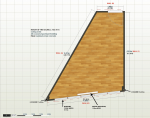Hi everyone. It's my first post here, where I always stumble upon a lot of great advice. I've searched the forums but was not able to find a situation similar to mine, so I created a new post.
I'm a composer, and just moved to a new space (apartment building) and trying to put together a decent sounding home studio in one of the rooms. I've read quite a few articles on speaker and absorption panel placement, however they almost always assume the room is rectangular. So I'm having difficult time figuring out where to place my speakers and desk.
Speaking from the experience you have, where do you think would be the ideal placement for speakers? Also how close should the speakers be placed for the best sound. I will be using Adam A7X monitors.
Drawing and dimensions are pretty precise and column 1 and 2 shows the exact shape of the corners. Not sure if it is suitable for or requires the use of bass traps.
Wall A: Adjacent building
Wall B: Hallway
Wall C: My living room
Wall D: Outside
Thanks for the help

Yigit K. Guc
I'm a composer, and just moved to a new space (apartment building) and trying to put together a decent sounding home studio in one of the rooms. I've read quite a few articles on speaker and absorption panel placement, however they almost always assume the room is rectangular. So I'm having difficult time figuring out where to place my speakers and desk.
Speaking from the experience you have, where do you think would be the ideal placement for speakers? Also how close should the speakers be placed for the best sound. I will be using Adam A7X monitors.
Drawing and dimensions are pretty precise and column 1 and 2 shows the exact shape of the corners. Not sure if it is suitable for or requires the use of bass traps.
Wall A: Adjacent building
Wall B: Hallway
Wall C: My living room
Wall D: Outside
Thanks for the help


Yigit K. Guc
